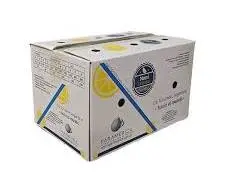ndia is a land of sunshine, and with that sunshine comes an abundance of citrus. Among these, the humble lemon stands out as a fruit with immense global demand. From refreshing beverages to culinary staples and even industrial uses, the demand for fresh, high-quality lemons is consistently high across the world.
For Indian entrepreneurs, this presents a zestful opportunity: transforming our bountiful lemon harvests into a thriving international business.
But exporting a perishable fruit like a lemon comes with its unique set of challenges and requirements. This comprehensive guide will walk you through every step, from selecting the right variety and mastering cold chain logistics to navigating international regulations and finding your top global buyers.

Part 1: The Juicy Opportunity – Why Export Indian Lemons?
Before we dive into the 'how,' let's understand the 'why.' The global market for lemons is robust and growing, driven by several key factors:
Year-Round Demand: Lemons are a kitchen staple worldwide, with consistent demand for culinary, beverage, and industrial applications.
Health & Wellness Trend: Rich in Vitamin C and antioxidants, lemons align perfectly with the global health and wellness movement.
India's Production Powerhouse: India is one of the world's largest producers of lemons and limes, giving us a significant advantage in terms of supply volume, variety, and competitive pricing.
Strategic Market Gaps: Indian lemon varieties can fill supply gaps in various markets, especially during off-seasons for local European or other major producers.

Part 2: Essential Varieties for Export
Not all lemons are created equal, especially for the export market. You need to focus on varieties that meet international standards for size, appearance, shelf life, and juice content.
Kagzi Kalan: A popular Indian variety, known for its thin skin, high juice content, and strong aroma. It's often used interchangeably with limes for many global culinary applications.
Lisbon & Eureka (Imported Varieties Grown in India): These are more commonly recognized international lemon varieties, known for their oval shape, thick rind, and high acidity. They often fetch premium prices.
Nepali Round: Another common Indian variety, suitable for processing or fresh consumption in specific markets.
Key Tip: Your target market will dictate the preferred variety. European markets often prefer the larger, thicker-skinned varieties for visual appeal, while some Middle Eastern markets are more open to smaller, juicier limes.

Part 3: The A-Z Export Process: From Farm to Foreign Shore
Exporting fresh produce like lemons demands meticulous planning and execution.
Step 1: Your Business & Legal Foundation
Register Your Company: Choose a legal structure (Proprietorship, LLP, Pvt. Ltd. Co.) and register it.
Get Your IEC (Importer-Exporter Code): This is your mandatory 10-digit license from the DGFT (Directorate General of Foreign Trade). Apply online.
GST Registration: Obtain a GSTIN. Exports are zero-rated, but you need GST registration to claim Input Tax Credit on your purchases.
Open a Business Current Account: A dedicated bank account is essential for all transactions.
Step 2: Crucial Export Registrations & Certifications
APEDA RCMC: Obtain a Registration-Cum-Membership Certificate from APEDA (Agricultural and Processed Food Products Export Development Authority). This is non-negotiable for fresh produce.
GLOBALG.A.P. Certification (Highly Recommended): While not always legally mandatory for all markets, major buyers in Europe will demand this. GLOBALG.A.P. is an international standard for good agricultural practices, covering food safety, sustainability, worker welfare, and traceability.
Phytosanitary Certificate: This is a crucial document issued by India's Plant Protection Organisation, certifying that your lemons are free from pests and diseases. This is mandatory for almost all fresh produce exports.
Step 3: Sourcing & Quality Control
Sourcing Regions: Key lemon-producing states include Andhra Pradesh, Maharashtra, Gujarat, and Tamil Nadu.
Direct from Farmers/FPOs: Establish direct relationships with farmers or Farmer Producer Organizations (FPOs). This ensures better quality control and traceability.
Harvesting & Pre-Cooling: Lemons must be harvested carefully to avoid bruising. Immediate pre-cooling (reducing field heat) is vital to extend shelf life.
Grading & Sorting: Lemons must be uniformly graded by size, color, and freedom from defects. Automated grading lines in modern packhouses are ideal.
Washing & Waxing: Lemons are typically washed to remove dirt and then waxed (food-grade wax) to enhance shine and reduce moisture loss, which is critical for long transit times.
Step 4: Packaging & Labeling (The Cold Chain is King!)
Packaging: Lemons are usually packed in corrugated cardboard boxes designed for ventilation. Each lemon may also be individually wrapped in tissue paper for premium exports.
Labeling: Your cartons must clearly display:
Product Name ("Fresh Lemons")
Variety
Count/Size Grade
Net Weight
Country of Origin ("Product of India")
Packhouse Registration Number
GLOBALG.A.P. logo (if certified)
The Cold Chain: This is the most critical aspect for perishable goods.
Reefer Containers: Lemons must be shipped in refrigerated "reefer" containers at optimal temperatures (typically 6-8°C, depending on variety and ripeness) and controlled humidity.
Continuous Monitoring: Ensure your logistics partner provides real-time temperature monitoring. A single temperature fluctuation can ruin an entire shipment.
Step 5: Logistics & Shipping
Freight Forwarder: Partner with an experienced freight forwarder specializing in reefer cargo and perishable goods. They will manage ocean freight (or air freight for high-value, fast shipments), customs clearance, and all associated paperwork.
Port Selection: Utilize major ports with excellent reefer container handling facilities, such as JNPT (Nhava Sheva), Mundra, and Chennai.
HS Code: The Harmonized System (HS) Code for fresh lemons (and limes) is typically 08055000.
Step 6: Mandatory Export Documents
Commercial Invoice cum Packing List
Bill of Lading (for sea freight) or Airway Bill (for air freight)

Certificate of Origin
Phytosanitary Certificate
APEDA RCMC
GLOBALG.A.P. Certificate (if required by buyer)
Container Temperature Log (from reefer container)
Part 4: Top Global Buyers for Indian Lemons
While Indian lemons are sold worldwide, here are some key markets where demand is high and you can establish strong relationships:
1. Middle East (UAE, Saudi Arabia, Kuwait)
Why They Buy: Proximity to India, strong culinary demand, and established trade routes make the Middle East a primary market. They appreciate the strong aroma and juice content of Indian varieties.
Preferred Type: Often open to both smaller limes and larger lemons, used extensively in salads, drinks, and main courses.
Market Nuance: This market can be price-sensitive but also appreciates consistent supply and quality.
2. European Union (Germany, Netherlands, UK – post-Brexit)
Why They Buy: High consumer purchasing power, a strong focus on healthy eating, and a demand for diverse culinary ingredients. The Netherlands acts as a major re-export hub for all of Europe.
Preferred Type: Tend to prefer larger, visually appealing, thicker-skinned lemon varieties (like Lisbon/Eureka types). GLOBALG.A.P. certification and strict MRL (Maximum Residue Levels) compliance are non-negotiable.
Market Nuance: This is a high-value, but highly regulated and competitive market. Quality, safety, and certifications are paramount.
3. Southeast Asia (Malaysia, Singapore)
Why They Buy: Growing economies, large Indian diaspora communities, and a high usage of citrus in their local cuisines (especially limes/kagzi for Asian cooking).
Preferred Type: Smaller, juicier varieties are often preferred.
Market Nuance: Can be a good entry point due to relatively less stringent regulations compared to the EU, but still requires good cold chain management.
Part 5: Further Resources & Related Blogs
To help you on your export journey, here are some other valuable resources:
VIDEO: A Guide to Starting Your Banana Fiber Business: While not directly about lemons, this video (link below) discusses the "waste-to-wealth" concept and setting up a processing unit, which has parallels for any agricultural value addition. https://www.youtube.com/watch?v=rVYjB4au-wY
BLOG: The Great Indian Tea Paradox: Why We Import AND Export: Learn about another complex Indian agricultural export story. [Link to Your Tea Blog Here]
BLOG: Unlocking the EU Market: A Guide to India's Top 3 Agricultural Exports: Get more in-depth on EU regulations for fresh produce. [Link to Your Top 3 Agri-Exports Blog Here]
Conclusion: Zest for Success!
Exporting lemons from India is a challenging but incredibly rewarding venture. It taps into global demand for a versatile, healthy fruit and leverages India's immense agricultural strength. By mastering quality control, adhering to international standards, and focusing on efficient cold chain logistics, you can transform Indian lemons into a sweet success story on the global stage.
The world is ready for a taste of Indian sunshine. Are you ready to deliver?